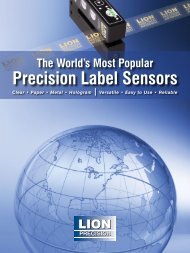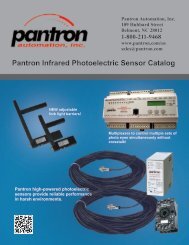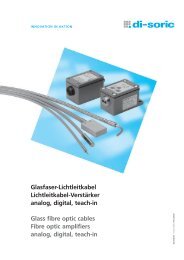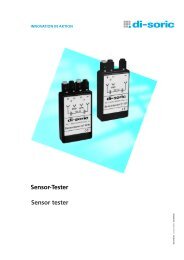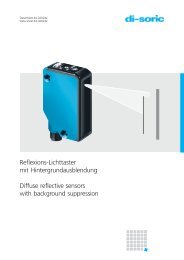High and Low-frequency Radio Frequency Identification Systems (RFID)
Radio Frequency Identification Systems (PDF) - Pantron Automation ...
Radio Frequency Identification Systems (PDF) - Pantron Automation ...
- No tags were found...
Create successful ePaper yourself
Turn your PDF publications into a flip-book with our unique Google optimized e-Paper software.
<strong>High</strong>-<strong>frequency</strong><br />
Technology<br />
Max. Read/write distance<br />
RLS-1183-020<br />
RLS-1303-020<br />
RTP-0090-020 12 mm 12 mm<br />
RTP-0201-020 14 mm 25 mm<br />
RTP-0301-020 26 mm 45 mm<br />
RTP-0501-020 31 mm 60 mm<br />
Introduction<br />
The operating principle of 13.56 MHz systems is comparable to that of low-<strong>frequency</strong><br />
technology: Transponders are passive, i.e. they have no built-in battery.<br />
The operating energy required is transmitted by the read/write module in the form<br />
of a carrier (electromagnetic wave). During communication between the transponder<br />
<strong>and</strong> the read/write module, this carrier is modulated by the data exchanged.<br />
Since the read/write distances of high-<strong>frequency</strong> components are greater than<br />
those of low-<strong>frequency</strong> models, the high-<strong>frequency</strong> technology features an anticollision<br />
algorithm. This algorithm allows for all transponders in the vicinity of a read/<br />
write module to be recognized <strong>and</strong> for a specific transponder to be addressed.<br />
HF ConIdent® <strong>RFID</strong> system<br />
Contrinex has developed a range of high-<strong>frequency</strong> <strong>RFID</strong> components which are<br />
compatible with ISO/IEC 15693. Consequently, Contrinex read/write modules may<br />
communicate with all compliant tags, i.e. not only with those offered by Contrinex.<br />
The table below shows all transponders that can be used with the Contrinex HF<br />
<strong>RFID</strong> system (incl. manufacturer information).<br />
Manufacturer<br />
Type<br />
User<br />
memory<br />
(byte)<br />
Memory<br />
type<br />
EM Marin EM4135 304 EEPROM<br />
EM Marin EM4034 56 EEPROM EAS<br />
Specific functions<br />
(not covered by<br />
st<strong>and</strong>ard)<br />
EM Marin EM4035 400 EEPROM EAS / Crypto<br />
Infineon SRF55V02P 256 EEPROM<br />
Infineon SRF55V02S 256 EEPROM Safety<br />
Infineon SRF55V10P 1024 EEPROM<br />
Infineon SRF55V10S 1024 EEPROM Safety<br />
LEGIC ATC128-MV 128 EEPROM Safety, crypto<br />
LEGIC ATC256-MV 256 EEPROM Safety, crypto<br />
LEGIC ATC1024-MV 1024 EEPROM Safety, crypto<br />
NXP I-CODE SL2 ICS20 96 EEPROM EAS<br />
NXP I-CODE SLI-L SL2 ICS50/51 64 EEPROM EAS, safety, “KILL”<br />
NXP I-CODE SLI-S SL2 ICS53/54 256 EEPROM EAS, safety, “KILL”<br />
TI Tag-it HF-I Plus 256 EEPROM<br />
TI Tag-it HF-I Pro 32 EEPROM<br />
TI Tag-it HF-I St<strong>and</strong>ard 32 EEPROM<br />
ST LRI2k 256 EEPROM Kill Code<br />
ST LRIS2k 256 EEPROM Kill Code Password<br />
FUJITSU MB89R118 2000 FRAM EAS<br />
Initially, Contrinex transponders are equipped with an I-CODE SLI-S SL2 ICS53/54<br />
provided by NXP. It should be pointed out that the specific functions not covered<br />
by ISO/IEC 15693 are only offered by tags supplied by Contrinex.<br />
40 Detailed data sheets for these products can be found on the Contrinex website:




